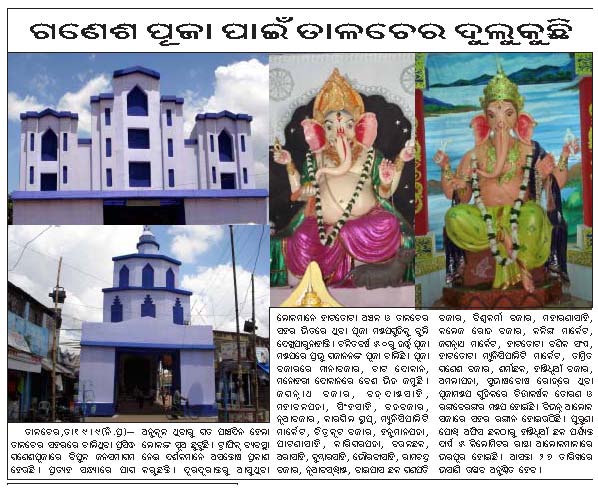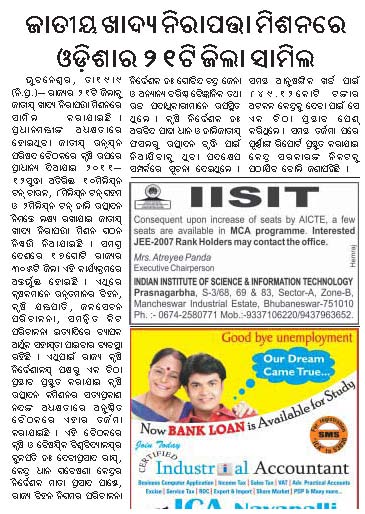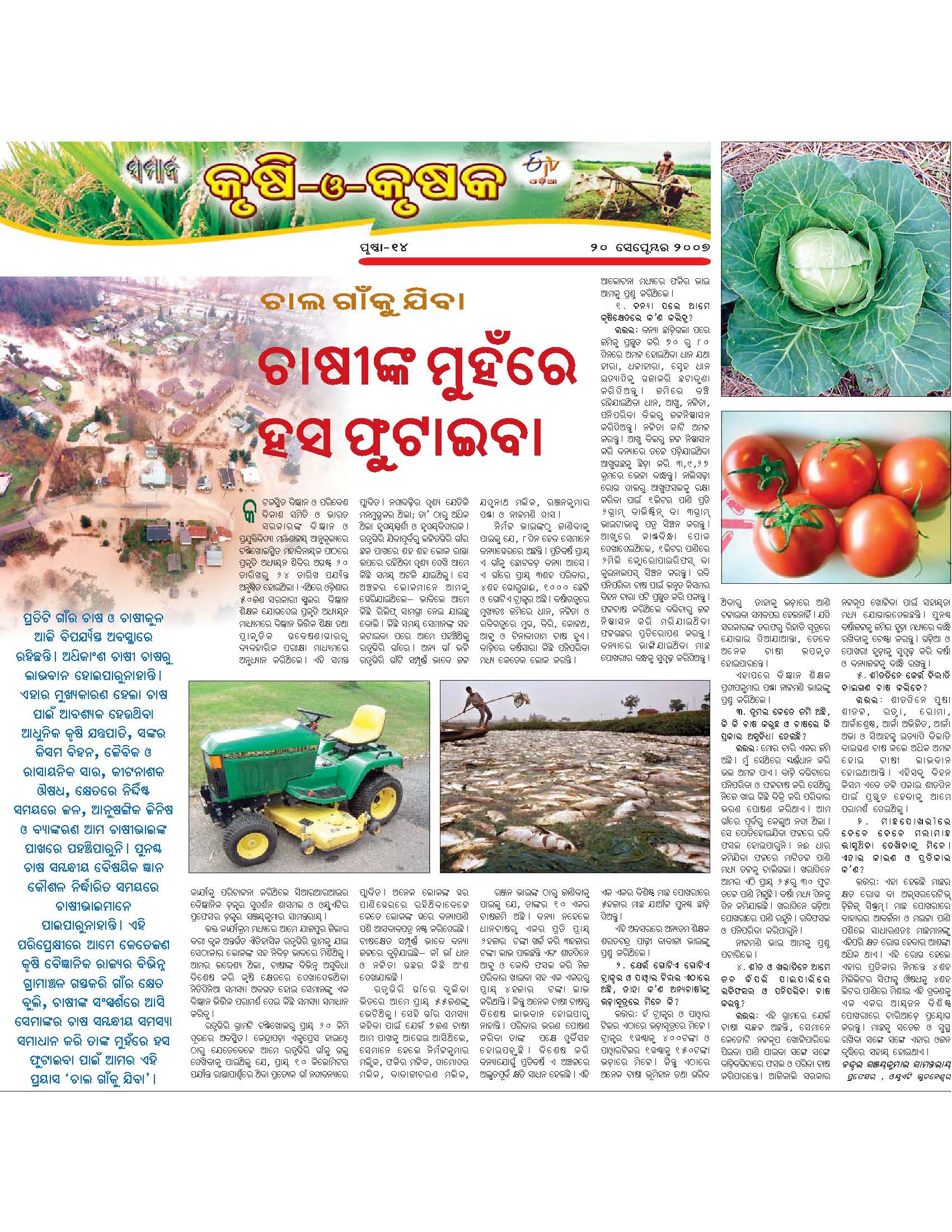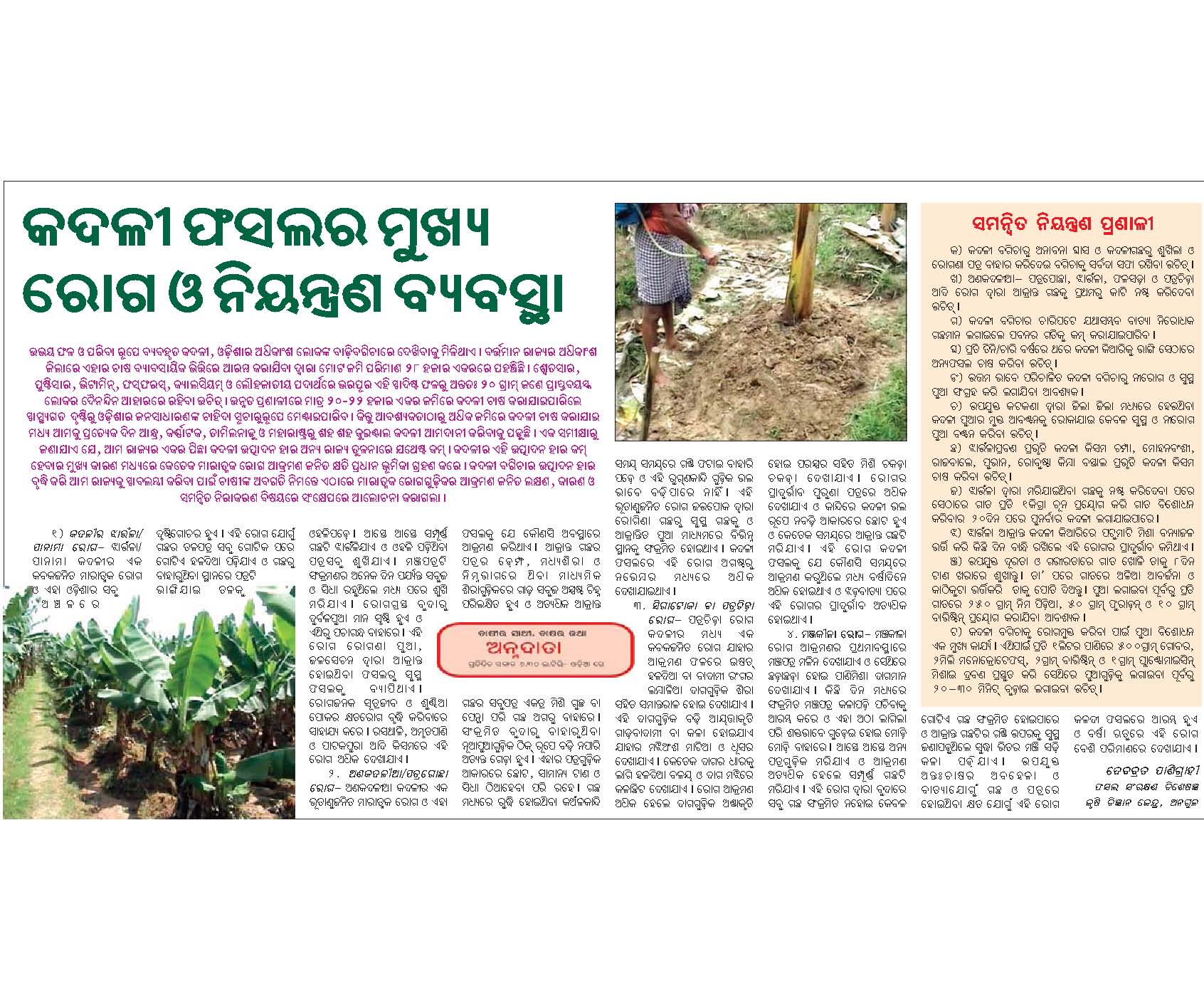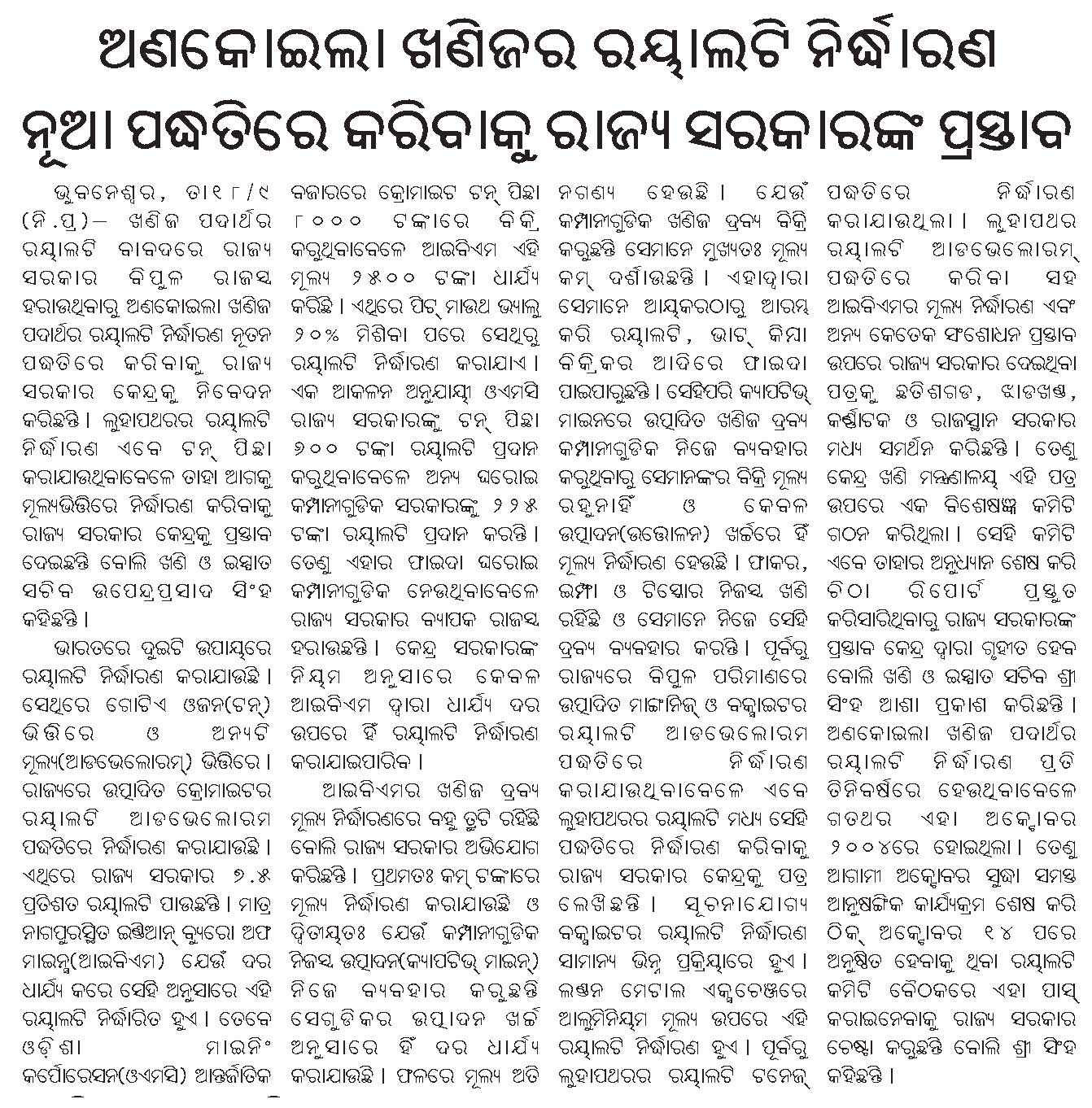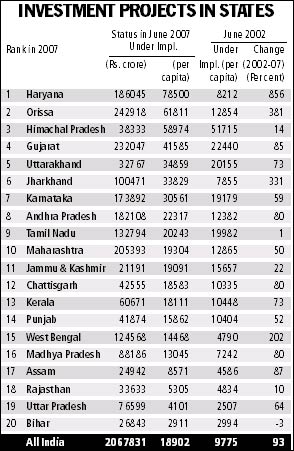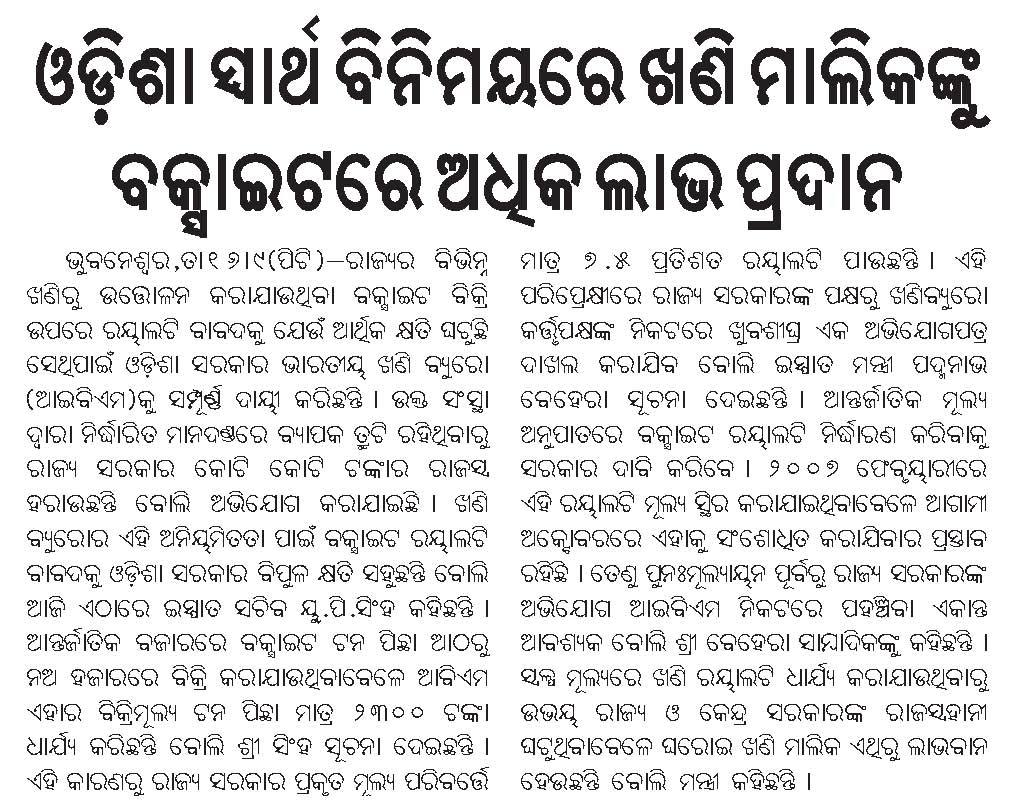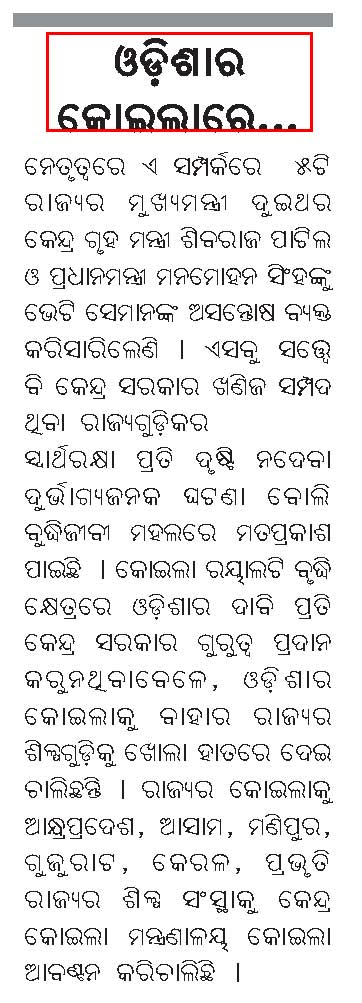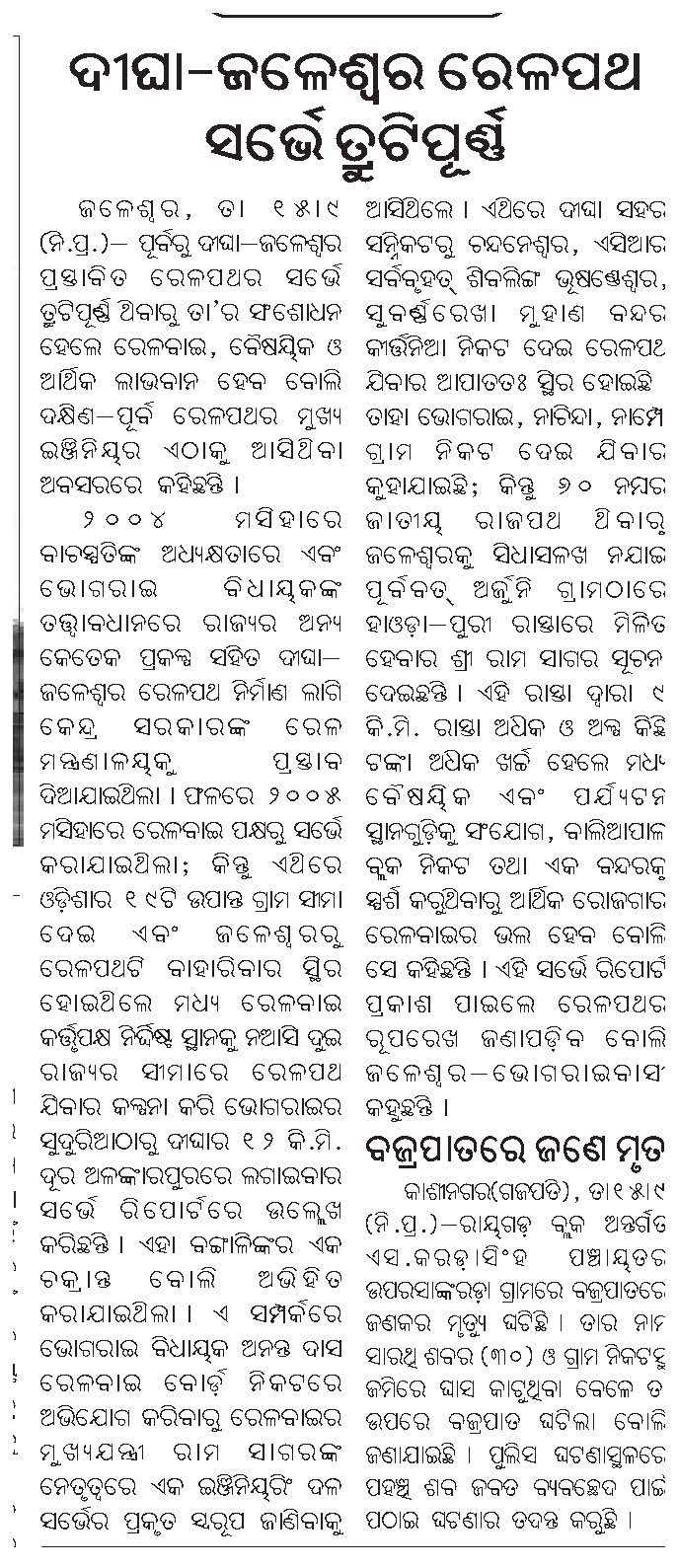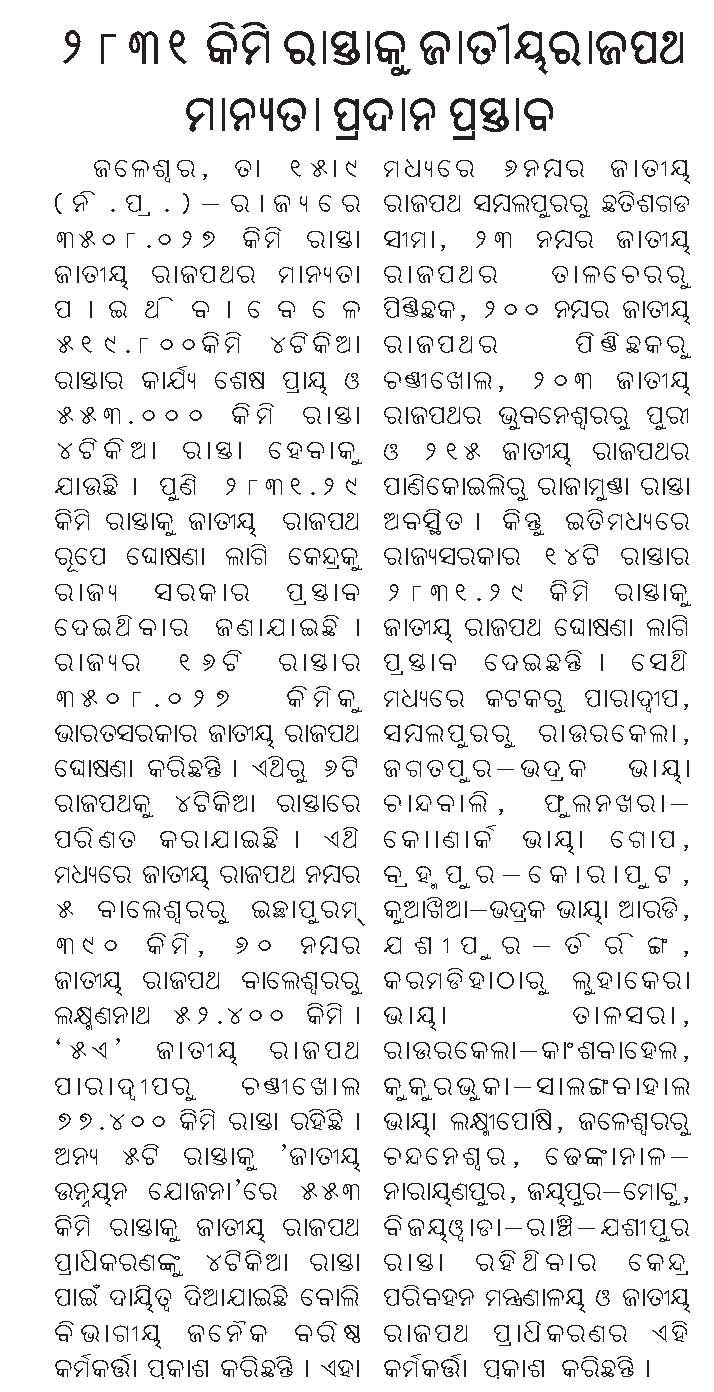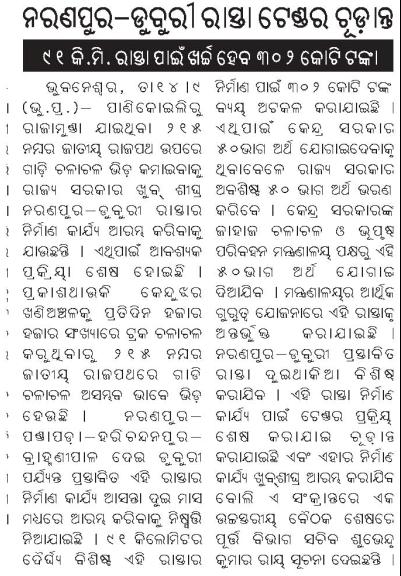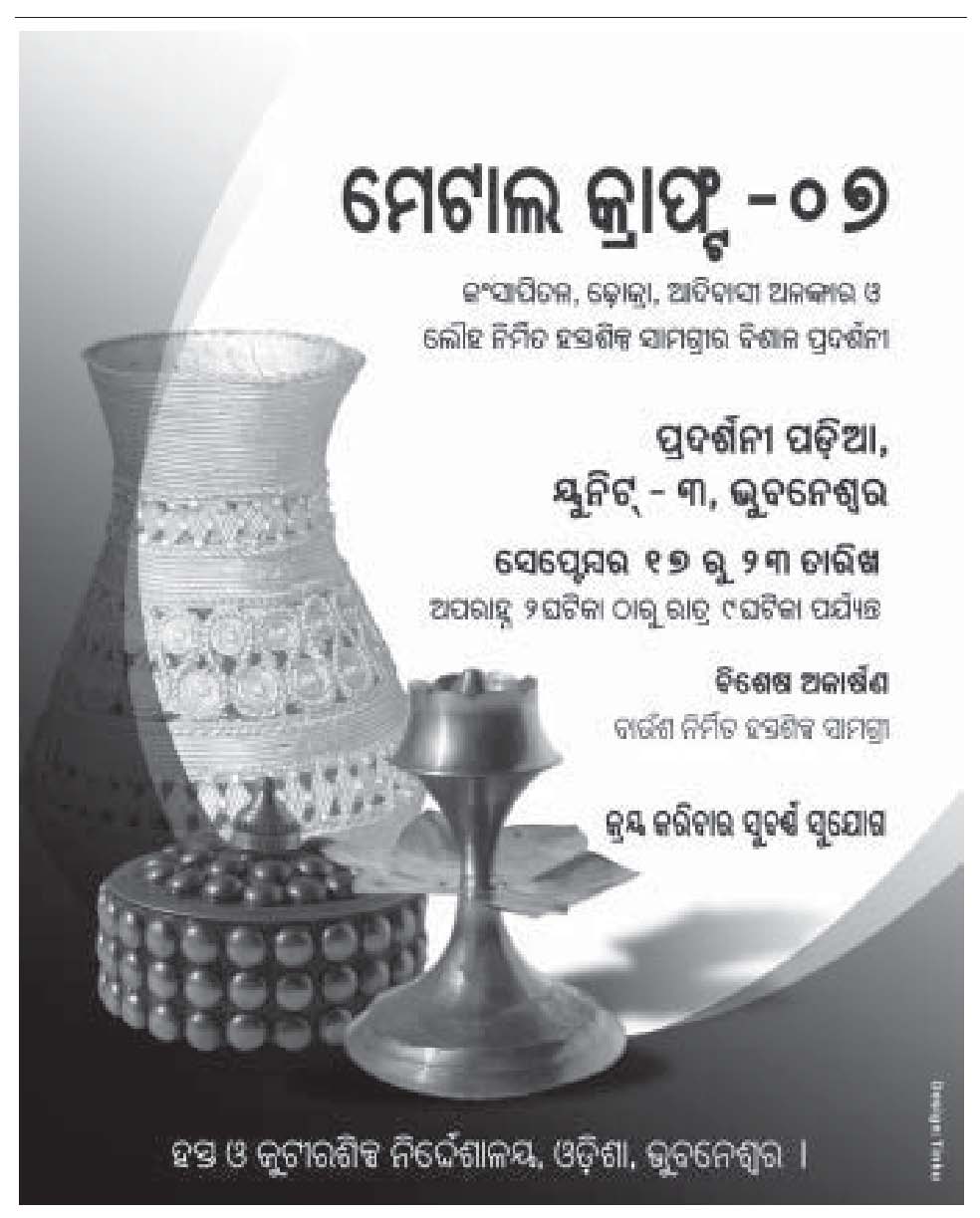Author Archive
Twentyone districts of Orissa are part of NFSM
National Food ... (NFSM) Comments Off on Twentyone districts of Orissa are part of NFSMPost flood farming, growing tomatoes etc.: Q & A in Samaja
AGRICULTURE & FARMING, Post-flood farming Comments Off on Post flood farming, growing tomatoes etc.: Q & A in SamajaArmy medical facilities in Orissa
Balasore, CENTER & ODISHA, Defence establishments, Ganjam, Khordha Comments Off on Army medical facilities in OrissaMedical facilities for ex-servicement in Orissa are currently available at INS Chilka, INHS Nivarini, Army AD College Gopalpur and the three ECHS Polyclinics at Bhubaneswar, Berhampur and Balasore.
As per a report in Pioneer, six more ECHS Polyclinics would be shortly inaugurated at Sambalpur. Dhenkanal, Angul, Puri, Bhawanipatna and Sundargarh.
Orissa’s proposal regarding royalty for non-coal minerals
MINES and MINERALS, Mining royalty, Odisha govt. action, State Bureaucrats (IAS, OAS, etc.) Comments Off on Orissa’s proposal regarding royalty for non-coal mineralsIBNLIVE talks to some affected people in Sukinda Valley
ENVIRONMENT, Jajpur, MINES and MINERALS Comments Off on IBNLIVE talks to some affected people in Sukinda ValleyFollowing are some excerpts from that report.
… Makara Dehuri’s been steadily losing weight. The 35-year-old miner from Ostpala village doesn’t know what’s wrong with him.
Over 2 lakh people in Sukinda suffer from some form of hexavalent chromium poisoning because of the untreated water discharged by the mines into the Brahmani River.
Sukinda contains one largest open cast chromite ore mines in the world. As much as 60 percent of drinking water here is poisoned.
“Drinking water is a major problem for us. If we tell our boss he will suspend us from our job,” says a villager in Orissa, Makara Dehuri.
The recent study has chosen these places for the severity of its toxins, its impact on human health and the extent of damage caused. …
Somebody should file a PIL or sue the government and the mining industry in Sukinda.
Baji Mohammad of Nabarangpur: P. Sainath writes about him
Odisha personalities Comments Off on Baji Mohammad of Nabarangpur: P. Sainath writes about himFollowing is a reproduction of an article about Baji Mohammad by P. Sainath.
Nine decades of non-violence
Countless rural Indians sacrificed much for India’s freedom, to fade into oblivion later, seeking neither reward nor recognition. Gandhian Baji Mohammed, who has been active for 70 years in one or the other cause, is amongst the last of this dying tribe, writes P Sainath.
“We were sitting in the tent, they tore it down. We kept sitting,” the old freedom fighter told us. “They threw water on the ground and at us. They tried making the ground wet and difficult to sit on. We remained seated. Then when I went to drink some water and bent down near the tap, they smashed me on the head, fracturing my skull. I had to be rushed to hospital.”
Baji Mohammed is one of India’s last living freedom fighters – just one of four or five nationally recognised ones still alive in Orissa’s Koraput region. He is not talking about British brutality in 1942. (Though he has much to say on that, too.) He’s describing the vicious attack on him during the demolition of the Babri Masjid in 1992, half a century later. “I was there as part of a 100-member peace team.” But the team was given no peace. The old Gandhian fighter, already in his mid-seventies, spent ten days in hospital and a month in a Varanasi ashram recovering from the injury to his head.
No hatred in his heart
There is not an iota of anger as he describes the event. No hatred towards the RSS or Bajrang Dal that led the attack. Just a gentle old man with a charming smile. And a firm Gandhi bakht. He’s a Muslim who heads the anti-cow slaughter league of Nabrangpur. “After the attack, Biju Patnaik came to my home and scolded me. He was worried about my being active even in peaceful protest at my age. Earlier, too, when I did not accept this freedom fighter’s pension for twelve years, he chided me.”
Baji Mohammed is a colourful remnant of a dying tribe. Countless rural Indians sacrificed much for India’s freedom. But the generation that led the nation to it is dying out swiftly, most of its members in their late 80s or 90s. Baji is closing in on 90.
“I was studying in the 1930s, but did not make it past matric. My guru was Sadashiv Tripathi who later became Orissa Chief Minister. I joined the Congress Party and became president of its Nabrangpur unit [then still a part of Koraput district]. I made 20,000 members for the Congress. This was a region of great ferment. And it came fully alive with satyagraha.”
However, while hundreds marched towards Koraput, Baji Mohammed headed elsewhere. “I went to Gandhiji. I had to see him.” And so he “took a cycle, my friend Lakshman Sahu, no money, and went from here to Raipur.” A distance of 350 km of very tough, mountainous terrain. “From there we took a train to Wardha and went on to Sewagram. Many great people were at his ashram. We were awed and worried. When could we meet him, if ever? Ask his secretary Mahadev Desai, people told us.”
“Desai told us to talk to him during his 5 p.m. evening walk. That’s nice, I thought. A leisurely meeting. But the man walked so fast! My run was his walk. Finally, I could no longer keep up and appealed to him: Please stop: I have come all the way from Orissa just to see you.”
“He said testily: “what will you see? I too, am a human being, two hands, two legs, a pair of eyes. Are you a satyagrahi back in Orissa?’ I replied that I had pledged to be one.”
“Go,’ said Gandhi. “Jao, lathi khao. (Go and taste the British lathis.) Sacrifice for the nation.’ Seven days later, we returned here to do exactly as he ordered us.” Baji Mohammed offered satyagraha in an anti-war protest outside the Nabrangpur Masjid. It led to “six months in jail and a Rs. 50 fine. Not a small amount those days.”
More episodes followed. “On one occasion, at the jail, people gathered to attack the police. I stepped in and stopped it. “Marenge lekin maarenge nahin,’ I said. (We shall die, but we shall not attack.)”
“Coming out of jail, I wrote to Gandhi: what now? And his reply came. “Go to jail again.’ So I did. This time for four months. But the third time, they did not arrest us. So I asked Gandhi yet again: now what? And he said: “take the same slogans and move amongst the people.’ So we went 60 km on foot each time with 20-30 people to clusters of villages. Then came the Quit India movement, and things changed.”
“On August 25, 1942, we were all arrested and held. Nineteen people died on the spot in police firing at Paparandi in Nabrangpur. Many died thereafter from their wounds. Over 300 were injured. More than a thousand were jailed in Koraput district. Several were shot or executed. There were over a hundred shaheed (martyrs) in Koraput. Veer Lakhan Nayak [legendary tribal leader who defied the British] was hanged.”
Baji’s shoulder was shattered in the violence unleashed against the protesters. “I then spent five years in Koraput jail. There I saw Lakhan Nayak before he was shifted to Berhampore jail. He was in the cell in front of me and I was with him when the hanging order came. What should I tell your family, I asked him. “Tell them I am not worried,’ he replied. ‘Only sad that I will not live to see the swaraj we fought for.'” Baji himself did. He was released just before Independence Day – “to walk into a newly free nation.” Many of his colleagues, amongst them future Chief Minister Sadashiv Tripathi, “all became MLAs in the 1952 elections, the first in free India.” Baji himself “never contested the polls. Never married.”
“I did not seek power or position,” he explains. “I knew I could serve in other ways. The way Gandhi wanted us to.” He was a staunch Congressman for decades. “But now I belong to no party,” he says. “I am non-party.” It did not stop him from being active in every cause which he thought mattered to the masses. Right from the time “I took part in the bhoodan movement of Vinoba Bhave in 1956.” He was also supportive of some of Jayaprakash Narayan’s campaigns. “He stayed here twice in the 1950s.” The Congress asked him to contest elections more than once. “But me, I was more sewa dal than satta dal. (More service oriented than power seeking.)”
Greatest moment
For freedom fighter Baji Mohammed, meeting Gandhi was “the greatest reward of my struggle. What more could one ask for?” His eyes mist over as he shows us pictures of himself in one of the Mahatma’s famous protest marches. These are his treasures, having gifted away his 14 acres of land during the bhoodan movement. His favourite moments during the freedom struggle? “Every one of them. But of course, meeting the Mahatma, hearing his voice. That was the greatest moment of my life. The only regret is that his vision of what we should be as a nation, that is still not realised.”
Just a gentle old man with a charming smile. And a sacrifice that sits lightly on ageing shoulders. ⊕
P Sainath
16 Sep 2007
Courtesy: The Hindu
P. Sainath is the 2007 winner of the Ramon Magsaysay award for Journalism, Literature, and Creative Communication Arts. He is one of the two recipients of the A.H. Boerma Award, 2001, granted for his contributions in changing the nature of the development debate on food, hunger and rural development in the Indian media.
Orissa number 2 in terms of investment projects under implementation
Investment ranking, INVESTMENTS and INVESTMENT PLANS, RESOURCE MOBILIZATION & BUDGETS Comments Off on Orissa number 2 in terms of investment projects under implementationIn an editorial page article in Indian Express, Ila Patnaik says the following about Orissa.
We examine data on projects under implementation in various states in the CMIE Capex data base. We compare data for June 2007 with June 2002 to assess how a state has fared on investment compared to its previous performance. … Orissa is also a major gainer, particularly over the last five years. It went from rank 8 to rank 2 over the last five years. While the Indian average for projects under implementation on a per capita basis grew by 93 per cent, Orissa gained by 381 per cent over the last five years to reach Rs 61,811 of investment per capita.
Light and Sound show at the Regional Science Center in Bhubaneswar: Sambada
Bhubaneswar- Cuttack- Puri, Khordha, Museums Comments Off on Light and Sound show at the Regional Science Center in Bhubaneswar: SambadaWhy is Bauxite royalty so low?
Bauxite, Mining royalty Comments Off on Why is Bauxite royalty so low?Orissa government’s ad in Samaja on their infrastructural achievements
Balangir, Cuttack, Jagatsinghpur, Jajpur, Khordha, Nayagarha, Odisha govt. ads, Roads, highways and Bus stands Comments Off on Orissa government’s ad in Samaja on their infrastructural achievementsReliance plans to take coal from Orissa and make power in UP: Samaja
Anil Ambani group, Coal, Thermal Comments Off on Reliance plans to take coal from Orissa and make power in UP: SamajaProblems with the survey of Jaleswar-Digha line: Samaja
Balasore, Railways, SER Comments Off on Problems with the survey of Jaleswar-Digha line: SamajaOrissa asks more of its roads to be designated as national highways: Samaja
Roads, highways and Bus stands Comments Off on Orissa asks more of its roads to be designated as national highways: SamajaProgress on the Mahanadi – Chitroptala project : Samaja
Mahanadi River Comments Off on Progress on the Mahanadi – Chitroptala project : SamajaProgress in Naranpur – Duburi highway : Samaja
Jajpur, Jajpur Rd- Vyasanagar- Duburi- Kalinganagar, Roads, highways and Bus stands Comments Off on Progress in Naranpur – Duburi highway : SamajaMore details on Sky Airways’ plan to fly to connect many Orissa towns
Airports and air connectivity, Jajpur, Jharsugurha, Keonjhar, Koraput, Rayagada, Sambalpur 3 Comments »Following up on the ad that appeared in Samaja, there have been several reports with more details. Following are excerpts from a New Indian Express report.
The airline will operate eight-seater aircraft from the Capital City to places like Barbil, Keonjhar, Jharsuguda, Jeypore, Sambalpur and Rayagada.
Ticket fare to Barbil would cost around Rs 5000 and to Jeypore Rs 7000. For corporate flyers and individuals buying to and fro tickets, a 40 percent discount can be availed of as an introductory offer.
General Manager (operations) Sumit Mukherjee said, those buying one-way ticket would also be given a 30 percent concession. Talking to mediapersons here, he said, the airline had already positioned one Islander BN2T turboprop aircraft capable of short takeoff and landing on these routes.
The travelling time would vary from 50 minutes to 1 hour and 15 minutes. Services would run on all days expect Sundays. A Bell 206 BIII helicopter with four seats would be introduced for charter service, he said. Sky Airways is a division of New Delhi-based GSI Pvt. Ltd and is headquartered in Kolkata.
… “We will introduce two aircraft to these places with a seating capacity for 19 passengers before the end of the current year.”
Another news item mentioned that they plan to fly from such towns to Kolkata in the future.
Island tourism for three Chilika islands
Chilika, Island tourism, TOURISM, ENTERTAINMENT and SHOPPING Comments Off on Island tourism for three Chilika islandsFollowing are excerpts on this from a New Indian Express report.
… Island tourism is a big hit elsewhere, but Orissa is waking up to it now for the first time. The Orissa Tourism and Chilika Development Authority have joined hands to launch it at three islands near Muggermukh from November.
Over 96,000 tourists – domestic and foreign – visited Chilika taking Satpada route in 2006 but most visitors take a boat ride, look to sight dolphins and go back home. But both Tourism Department and CDA want tourists to spend more time in the lagoon and that’s how the Island Tourism concept came into their minds.
The three islands near Muggermukh were identified by the CDA. Created out of dredged materials, the islands are of different sizes – largest being 21 acre and the smallest spread over eight acre.
According to Director, Tourism Rabi Narayan Nanda, private operators will be roped in to provide 3-star and 4-star tenting accommodation for visitors. …
The private vendor would take care of the transportation through fast-moving boats, food and accommodation, lighting as well as security measures. In fact, this will be marketed in attractive tourist packages, he said.
Called Dredged Islands 1, 2 and 3, these three are free from forest laws and do not come under Coastal Regulatory Zone provisions making the task easy for Tourism Department well as CDA. However, no construction will be allowed in the islands.
“We’ve developed these islands and carried out extensive plantation. Babul, Neem and Casuarina plants have given them a whole new face,” Chief Executive of CDA Sudarshan Panda said.
SAIL’s expansion plan for Rourkela
Iron Ore, Jajpur, Jajpur Rd- Vyasanagar- Duburi- Kalinganagar, Rourkela- Kansbahal, SAIL, Steel, Sundergarh 1 Comment »Update: The PIB http://pib.nic.in/release/release.asp?relid=33543 is a Rajya Sabha answer on this topic.
Following are excerpts from a Times of India report.
The Steel Authority of India (SAIL) on Wednesday unveiled plans to expand and modernise the Rourkela Steel Plant (RSP) with an investment of Rs 7,800 crore. RSP, which presently has a capacity of 2.2 million tonnes per annum, would be converted into a four MTPA facility by June, 2010. Its production would be further enhanced to eight MTPA by 2019-20, said company’s director (personnel and raw materials) G Ojha here. According to Ojha, RSP’s expansion is part of SAIL’s plan to invest Rs 49,000 crore in its different units and mines within the next three to three-and-half years. … Ojha said that post-expansion, SAIL’s production capacity would touch 26 MTPA of hot metal compared to its existing capacity of 14.6 MTPA. This would mean 23 MTPA of saleable steel," he informed. The company also intends to spend a substantial sum of money to improve its mining operations, including over Rs 1,100 crore in Orissa, he added. Regarding SAIL’s recent MoU with South Korean company Posco, the director said, "We want to indulge in exchange of technology and people. "We also plan collaboration in research and development activities and accordingly, an eight-member team, comprising four from each company, has been formed. This is just the beginning," he said. He allayed fears that the MoU could lead to SAIL’s privatisation and clarified that the pact was not legally enforceable and just an understanding for collaboration. … The SAIL director also reiterated the company’s interest to takeover the Neelachal Ispat Nigam Limited (NINL) in Orissa’s Jajpur district and said, IDBI, as an independent valuer, has already assessed the company’s worth. "In case the stakeholders (MMTC and Orissa government) have any reservations, then we are ready for further parleys. But, ideally, the valuers version should be honoured," he said.
Sukinda valley: 4th most polluted area in the world according to US-based Blacksmith institute
Chromite, Dhenkanal, Jajpur, Jajpur Rd- Vyasanagar- Duburi- Kalinganagar, Kalinganagar corridors, Mine related pollution, MINES and MINERALS, State Bureaucrats (IAS, OAS, etc.), Websites of Interest 2 Comments »Following is an excerpt from a Telegraph report.
Sukinda valley in Orissa�s Jajpur is one of the most polluted places in the world, according to a report by the US-based Blacksmith Institute.
The institute provides solutions to pollution-related problems.
From India, Sukinda has ranked fourth and Vapi, a 400km industrial belt in Gujarat, is fifth on the list of 10 most polluted places.
The valley, about 140km from here, is spread across Dhenkanal and Jajpur districts and has the largest chrome ore deposit in the country — 97 per cent of India�s reserves. Mining is done by the opencast method.
According to the report, �12 mines continue to operate without any environmental management plans and over 30 million tonnes of waste rock are spread over the surrounding areas. The mines discharge untreated water into the river. This area is also flood-prone, resulting in further contamination of the waterways.�
The problem is �beyond the means of the state to solve�.
Environmentalists said the report is damning evidence of the impact rampant mining has on Orissa.
… However, chairman of Orissa State Pollution Control Board L.N. Patnaik described the report as �silly�. �I see a lot of personal agenda behind the report. It is a design to stop mining activities. If there is mining, there would be some air pollution. But to say that Sukinda is one of worst polluted places in the world is ridiculous,� he said.
The comment by OSPC Board Chairman Mr. Patnaik is outrageous. He should talk about what steps his organization is taking, if any, to minimize pollution. Instead of saying that he talks about personal agenda. Does that mean OSPC is not taking any steps to reduce pollution?
Essar Steel’s plan near Paradip
Iron Ore, Jagatsinghpur, Paradip - Jatadhari - Kujanga, R & R, Steel, Thermal 41 Comments »Following are excerpts from a report in Statesman.
… Mr Bijay Kumar Panda, head of Essar Steel Orissa highlighted the advantages of his proposed project yesterday.
Mr Panda said that the people of Nuagada, Udayabata and Bijaychandpur are keen on an early establishment of the proposed steel plant.
Barring a couple of organizations, the people at large are interested in the project and they have accepted the RR policy adopted by the company, he claimed.
Mr Panda informed that Essar Steel Orissa Ltd (ESOL), which is fully owned by Essar Steel Ltd, is going to set up a 6 million tone per annum integrated steel plant at the cost of Rs 15,000 corers.
The project would require 1900 acres of land out of which 270 acres would be government land and the rest, private. He informed that the number of displaced families have not yet been ascertained because the land survey has not been completed.
He said that the company, the government and the people had all agreed to a rate of Rs 9.50 lakh per acre as compensation and that some people had already provided their land at the said rate.
Balram Parida of Nuagada village who had given his 70 decimals land for the project said he had also requested the Essar authority to emply his son. Speaking of the project, Mr Panda informed that the technology selected will be eco –friendly and increase the iron ore reserves. He said that a beneficiation plant is located at Joda and Barbil so beneficiated ore will be transported through a slurry pipe line to Joda. Supply of iron ore through the pipe line will be cheaper too, he added.
He also informed 5500 people will be employed. The company will set up a 200 mega watt captive thermal power plant.
Meanwhile, the Paradip Krushak Manch has threatened to agitate if Essar failed to increase the compensation to Rs 25 lakh per acre.
